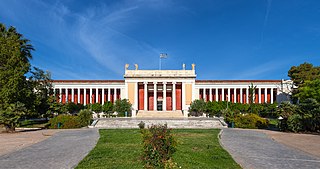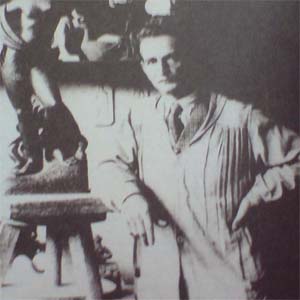
Kerameikos also known by its Latinized form Ceramicus, is an area of Athens, Greece, located to the northwest of the Acropolis, which includes an extensive area both within and outside the ancient city walls, on both sides of the Dipylon (Δίπυλον) Gate and by the banks of the Eridanos River. It was the potters' quarter of the city, from which the English word "ceramic" is derived, and was also the site of an important cemetery and numerous funerary sculptures erected along the road out of the city towards Eleusis.

Marble is a metamorphic rock composed of recrystallized carbonate minerals, most commonly calcite or dolomite. Marble is typically not foliated, although there are exceptions. In geology, the term marble refers to metamorphosed limestone, but its use in stonemasonry more broadly encompasses unmetamorphosed limestone. Marble is commonly used for sculpture and as a building material.

The Parthenon is a former temple on the Athenian Acropolis, Greece, dedicated to the goddess Athena, whom the people of Athens considered their patron. Construction began in 447 BC when the Athenian Empire was at the peak of its power. It was completed in 438 BC, although decoration of the building continued until 432 BC. It is the most important surviving building of Classical Greece, generally considered the zenith of the Doric order. Its decorative sculptures are considered some of the high points of Greek art. The Parthenon is regarded as an enduring symbol of Ancient Greece, Athenian democracy and Western civilization, and one of the world's greatest cultural monuments. To the Athenians who built it, the Parthenon and other Periclean monuments of the Acropolis were seen fundamentally as a celebration of Hellenic victory over the Persian invaders and as a thanksgiving to the gods for that victory.

The Mausoleum at Halicarnassus or Tomb of Mausolus was a tomb built between 353 and 350 BC in Halicarnassus for Mausolus, a satrap in the Achaemenid Empire, and his sister-wife Artemisia II of Caria. The structure was designed by the Greek architects Satyros and Pythius of Priene. Its elevated tomb structure is derived from the tombs of neighbouring Lycia, a territory Mausolus had invaded and annexed circa 360 BC, such as the Nereid Monument.

The Elgin Marbles also known as the Parthenon Marbles, are a collection of Classical Greek marble sculptures made under the supervision of the architect and sculptor Phidias and his assistants. They were originally part of the temple of the Parthenon and other buildings on the Acropolis of Athens.

Orsanmichele is a church in the Italian city of Florence. The building was constructed on the site of the kitchen garden of the monastery of San Michele, which no longer exists.

Panayiotis Vassilakis, also known as Takis, was a self-taught Greek artist known for his kinetic sculptures. He exhibited his artworks in Europe and the United States. Popular in France, his works can be found in public locations in and around Paris, as well as at the Athens-based Takis Foundation Research Center for the Arts and Sciences.

The sculpture of ancient Greece is the main surviving type of fine ancient Greek art as, with the exception of painted ancient Greek pottery, almost no ancient Greek painting survives. Modern scholarship identifies three major stages in monumental sculpture in bronze and stone: the Archaic, Classical (480-323) and Hellenistic. At all periods there were great numbers of Greek terracotta figurines and small sculptures in metal and other materials.

A pinacotheca was a picture gallery in either ancient Greece or ancient Rome. The name is specifically used for the building containing pictures which formed the left wing of the Propylaea on the Acropolis at Athens, Greece. The Pinacotheca was located next to the temple of Athena Nike. Though Pausanias speaks of the pictures "which time had not effaced", which seems to point to fresco painting, the fact that there is no trace of preparation for stucco on the walls shows that the paintings were easel pictures. The Romans adopted the term for the room in a private house containing pictures, statues, and other works of art.

The National Archaeological Museum in Athens houses some of the most important artifacts from a variety of archaeological locations around Greece from prehistory to late antiquity. It is considered one of the greatest museums in the world and contains the richest collection of artifacts from Greek antiquity worldwide. It is situated in the Exarcheia area in central Athens between Epirus Street, Bouboulinas Street and Tositsas Street while its entrance is on the Patission Street adjacent to the historical building of the Athens Polytechnic university.

In ancient Greek civilization, Nike was a goddess who personified victory. Her Roman equivalent was Victoria.

The National Art Gallery–Alexandros Soutzos Museum is an art museum located in the Pangrati district, Athens, Greece. It is devoted to Greek and European art from the 14th century to the 20th century. It is directed by Marina Lambraki-Plaka.

A lapidarium is a place where stone monuments and fragments of archaeological interest are exhibited.

Yannoulis Chalepas was a Greek sculptor and significant figure of Modern Greek art.

National Glyptotheque is a sculpture museum located in Athens, Greece. It is an annex of the National Gallery of Greece. The museum was established in 2004 and became the first National Glyptotheque of Greece. It houses a permanent collection of Greek sculpture from the 19th and the 20th centuries and temporary exhibitions, mainly of sculpture. The museum is based in two buildings of the former royal stables and a surrounding area of 6,500 m2, situated at the "Alsos Stratou" in Goudi.
Juraj Dobrović is a Croatian artist working in the media of sculpture, painting and graphic arts. The focus of his art is mainly oriented towards geometrical structures. He makes use of light effects to emphasize the plasticity of the form. Dobrović's works are closely related to the principles of Geometric abstraction and Neo-constructivism. He lives and works in Zagreb, Croatia.

Ivo Kerdić (1881–1953) was a Croatian sculptor, best known for his metalwork and medallions.

Hinko Juhn (1891–1940) was a Yugoslav sculptor, best known for his ceramics. He studied at the Arts & Crafts College in Zagreb and the International Academy in Florence, and took specialist classes in ceramics in the Czech Republic, Germany and at the Vienna School of Applied Arts. On his return to Zagreb, he exhibited his work at the Spring Salon and introduced ceramic techniques to a new generation of Yugoslav artists through his teaching.

Ancient Greek art stands out among that of other ancient cultures for its development of naturalistic but idealized depictions of the human body, in which largely nude male figures were generally the focus of innovation. The rate of stylistic development between about 750 and 300 BC was remarkable by ancient standards, and in surviving works is best seen in sculpture. There were important innovations in painting, which have to be essentially reconstructed due to the lack of original survivals of quality, other than the distinct field of painted pottery.
The Open Air Glyptotheque of Psychiko – George Zongolopoulos Square is a sculpture garden located in Psychiko, Athens, Greece, on Dimokratias Avenue next to Saint Dimitrios Church. It can be visited throughout the day.

















